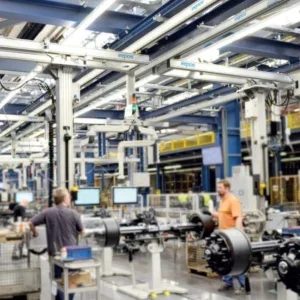The AC drive is being accepted as the standard control for most crane manufacturers today. The two main reasons why this technology is being accepted over wound rotor control are cost savings and reliability. AC drives are an economical upgrade for controlling low-horsepower DC motors. The upgrade reduces maintenance and parts costs and decreases down time. AC motors are standard off-the-shelf components, as are the drives. Drives in general should increase motor life because the motors generate less heat.
Crane 608, lifting capacity 40 ton (36t) is the principal crane in the hot strip mill at Stelco’s Lake Erie Steel Works (LEW), Hamilton, Ontario, Canada. Canadian Overhead Handling recently upgraded crane 608’s hook block rotation motor from DC to AC control.
The upgrade to AC control had to be more reliable than the DC control, save on maintenance costs and be safer. The customer requested using a standard AC motor that fits into the DC footprint and to use the existing rotate drive sheave arrangement. It also wanted a standard AC drive.
We came up with a drive package that would take the existing DC control and output AC into the motor mounted on the hook block.
The cabinet, which was a NEMA 12, has the dynamic braking resistor mounted on the top of the cabinet. The cabinet was mounted in the same space as the old DC rotate control using the existing DC control disconnect.
This rotate control cabinet was installed in the control house on the trolley.
The wiring for the control cabinet to the hook block remained the same since the cable reel had four conductors down to the hook block. The control from both the radio control and cab remained unchanged.
COH chose a Converter Concepts AC variable frequency drive for this application, since the output voltage to the motor was slightly higher than other drive manufacturers. Since this project we have standardized with either Magnetek Electromotive Systems or ABB drives.
The input voltage to the drive on the crane is between 230 and 270 DC. We have installed a DC choke on the positive input to the drive. Since this installation, we have started using two DC chokes – one on the positive and one on the negative. This choke was installed to prevent the drive from tripping when the input feed has any voltage spikes on the line into the drive.
The DC power inputted directly into the input rectifier though the AC bridge. This DC inputted power is then fed to the DC bus in the drive. The control of the drive controls this DC bus, which sends a PWM (Pulse Width Modulation) of the voltage to the motor. The drive output controls the frequency of the voltage to the motor.
The output of the drive has a reduced voltage since the input is DC. The reduced output voltage from the drive to the motor selection is critical.
To determine the output from the drive we can use the following calculation:

Vp is the peak voltage and RMS is the root mean square (0.827). With a 250V DC voltage, the equation gives 213.75V AC to the rotate motor.
With this reduced voltage from the drive it is important to select a motor that is both inverter duty and the correct voltage. All inverter duty motors have extra insulation on the winding, to take the additional heat, since the motor can run at very low rpms for extended periods of time.
The output of the drive to the motor has a common mode choke. The choke is installed at the drive output, which helps to guard against interference with other electrical equipment (PLCs, sensors, analog circuits etc.)
The motor was sized to five horsepower to ensure the new motor and drive had enough torque for the hook rotate. We used a standard 184T frame motor, to ensure minimal changes to the hook block motor base.
On this application the control of the drive remained the same. We installed new control relays that operated at 250 volts DC. The control can also be at 24 volts DC by changing the control relay coils.
We also added a Metal Oxide Varistor (MOV). This ensures no voltage spikes across the control contacts.
The control of the rotation is critical to the operators since the operation of the crane requires the operators to make very precise movements with the rotate during the maintenance on the hot strip mill.
With the AC control on the hook rotate, LEW are able to control both acceleration and deceleration of the hook block. This improved control provides a more precise operation of the hook block, since the ramp can be adjusted to meet the operator needs. This increase in control has reduced the incidence of operator complaints and crane abuse.
At the time of the installation our engineering department felt that a brake was needed to ensure the rotate remained stationary. After commissioning the brake was removed due to the large input to output ratio of the rotate reducer.
This rotate control was installed in June 1998 and since then the rotate control and motor have operated with virtually no down time and maintenance requirements.






